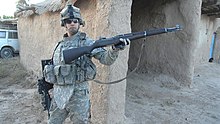
Weapons diversion is a situation in which weapons and ammunition are taken from their originally intended recipients. This can include equipment originally intended for use by the armed forces of one country being sold to a different country, but the most common cause of weapons diversion involves the capture of weapons during warfare. Weapons diversion can contribute to arms trafficking and other forms of organized crime.
Battlefield capture
Across 321 cases involving 183 weapons and 3,600 rounds of ammunition, Conflict Armament Research found that 30% of all weapons diversions were due to battlefield capture. Of the weapons captured, 16% had been manufactured within the last eight years, meaning that diversion can occur within just a few years of the initial manufacture and export.
Prevention
The prevention of weapons diversion was a significant part of the 2014 Arms Trade Treaty. As part of the treaty, signatories are required to implement mitigation measures in arms sales and assess the likelihood of diversion.
References
- Parrish, Antwaun. "AMCOM executes delivery of two CH-47F Chinook helicopters to Australia Defense Force". United States Army. Archived from the original on October 21, 2021. Retrieved 2021-10-18.
- "Detecting and preventing firearms diversion through end-use monitoring: examples from the US (US Blue Lantern end-use monitoring program: firearms cases)". Arms trafficking, arms trade, and weapons ID docs. March 29, 2016. Archived from the original on July 3, 2023.
- ^ Typology of Diversion. Conflict Armament Research. 2018. p. 10. Archived from the original on February 12, 2023.
- Raymond, Jessie. "Institute Alumni Discuss Risks of Weapons Diversion". Middlebury Institute of International Studies at Monterey. Archived from the original on August 8, 2022. Retrieved 2021-10-07.
- Diversion and the Arms Trade Treaty (PDF). Stimson. 2021. p. 1. Archived from the original (PDF) on January 29, 2023.
- "Module 10: Preventing Diversion". Arms Trade Treaty Implementation Toolkit (PDF). United Nations Office for Disarmament Affairs. Archived from the original (PDF) on October 6, 2022.
- Tobin, Emma; Florquin, Nicolas; Lett, Jonah; Stohl, Rachel; Shiotani, Himayu (March 31, 2021). "Practical Tools for Addressing the Risk of Weapons Diversion". Middlebury Institute of International Studies at Monterey. Archived from the original on July 5, 2023. Retrieved 2023-07-04.
External links
- The Loss of Arms and Ammunition in Peace Operations: Mapping and Addressing the Challenge (Jefferson Brehm, Global Peace Operations Review)
- Making a Tough Job More Difficult: Loss of Arms and Ammunition in Peace Operations (Eric G. Berman et al, Small Arms Survey)